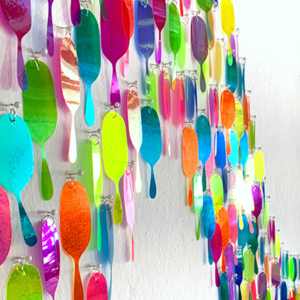Spectrum: Color in Pigment and Light
Audio Guide
Welcome to the ARTexperience Gallery
Audio Recording
Welcome to the ARTexperience Gallery
BAM’s ARTexperience Gallery was created to encourage hands-on exploration and multi-sensory experiences as valuable approaches to understanding art.
Boise Art Museum hopes it helps you investigate how art is made, who makes it, and the way ideas, feelings, creative approaches, and meaning are communicated through visual forms.
ARTexperience Gallery
was made possible in 1997 by generous support from:
Richard and Sondra Hackborn
Hackborn Foundation
William and Flora Hewlett Foundation
Hewlett Packard Company
Union Pacific Foundation
Helming Family Foundation
Willis R. and Elaine A. Nelson
Trout Architects
Lutheran Good Samaritan Society
Armstrong Planning and Design
Micron Internet Services
Stronghold Construction
Communication Wave
Micron Foundation
Introduction
Audio Recording
Spectrum: Color in Pigment and Light
For thousands of years, the rainbow has been a cross-cultural symbol of hope, positivity, and a bit of magic. Today, the rainbow is a recognizable, all-embracing icon of love, personal identity, and diversity. Dedicated to the celebration of rainbows, Spectrum showcases interactives inspired by the rich and numerous colors of our world. Participatory stations throughout the ARTexperience Gallery encourage visitors of all ages to create a rainbow block print, match colored fiber to emotions, build a colorful town, and more. A selection of artwork from BAM’s Permanent Collection is on view as part of this exhibition, which commemorates the relaunch of our interactive space at the Boise Art Museum. We are thrilled to incorporate, once again, touchable items, the art of play, and curiosity-seeking within Spectrum. We hope you enjoy exploring the colors of the rainbow at the Boise Art Museum.
Organized by the Boise Art Museum
Peter Coffin, Untitled (Rainbow Spiral, Pop-up Photo Album)
Audio Recording
Peter Coffin
(b. 1972, Berkeley, CA)
Untitled (Rainbow Spiral, Pop-up Photo Album),
Peter Norton Christmas Project, 2006
color photographs, bound album
Boise Art Museum Permanent Collection
Gift of Gwen Adams and Peter Norton

Make Your Own Rainbow Block Print
Audio Recording
Make Your Own Rainbow Block Print
Block printing is a method of printmaking in which the surface of a block is carved away leaving behind raised lines and shapes. When ink is applied to the surface of the block, and the block is pressed onto paper, the image is revealed!
Ink, Press, Print!
Follow the steps below to create a print, add your signature, and display for others to see.
- Take a piece of paper and slide it into the paper holder.
- Hold the block handle and lift the block off the base.
- Place the block on the ink pad and press down evenly.
- Place the inked block on top of the paper in the holder.
- Press down firmly to transfer the image onto the paper.
- Return the block to its home base.
Remove your paper from the holder and move to the next color inking step, and repeat steps 1 – 6 until you have a finished rainbow block print!

Wall case artwork: Lichtenstein & Estrada-Vega
Audio Recording
top:
Roy Lichtenstein
(1923-1997, New York, NY)
Landscape 7, 1967
screenprint with iridescent silver mylar collage
Boise Art Museum Permanent Collection
Gift of Allan P. and Lenore B. Sindler
bottom:
Carlos Estrada-Vega
(b. 1955, Chihuahua, NM)
Three Size Composition #5, 2000
oleopasto, wax, and pigments on wood
Boise Art Museum Permanent Collection
Gift of Wilfred Davis Fletcher for BAM’s 75th Anniversary
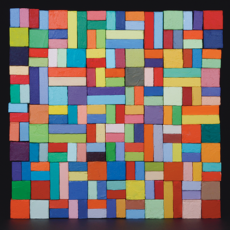
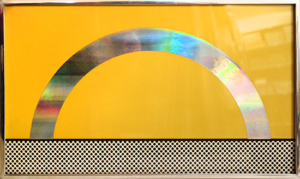
Wall case artwork: Thom Sempere, Triangular Color
Audio Recording
Thom Sempere
(b. 1954, Pontiac, MI)
Triangular Color, 1981
ektacolor print
Boise Art Museum Permanent Collection
Gift of the Artist

Color Words panel
Audio Recording
Color Words
Hue: Another word for color.
Value: The lightness (tint) or darkness (shade) of a color.
Warm/Cool Colors: Color temperature. Warm colors can seem energetic while cool colors can seem calm.
- Warm Colors – red, orange, yellow
- Cool Colors – green, blue, purple
Color Wheel: A circular diagram that organizes colors based on their relationships to each other.
Color Theory: The intentional combination of colors to create an emotion, mood, reaction, or visual effect.
- Analogous Colors: Colors located next to each other on the color wheel.
- Complementary Colors: Colors located directly opposite one another on the color wheel.
- Primary Colors: The primary colors of light are red, green, and blue. When you combine all colors of light, you get white light.The primary colors of pigment are red, yellow, and blue. When you combine all colors of pigment, they make black.
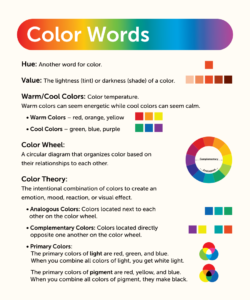
Experiment with Color
Audio Recording
Experiment with Color
Our perception of a single color is directly linked to the colors surrounding it. When a dark color is placed on a lighter color, it will appear darker through comparison. When the same color is placed on a darker color, it will appear lighter.
Try it!
You can experiment with color by observing how the same color appears to change when it is placed both on a light color and a dark color.
What happens when the same color is placed both on a warm color and a cool color?
What do you notice that changes?
- Pick a small color magnet. Take two of the same color.
- Place one small magnet in the center of a color in Experiment #1-5.
- Place the second small magnet in the center of the partner color in Experiment #1-5.
- Step back and observe. How have the colors changed in comparison to one another?
- Try moving the small magnets closer to the center dividing line to see what happens.
- Return the two small color magnets.
- Try again with a new color.

Unknown Artist, Roof tiles in the form of clouds
Audio Recording
Unknown Artist
Roof tiles in the form of clouds, 19th century
molded clay
Boise Art Museum Permanent Collection
Gift of Wilfred Davis Fletcher

Unknown Artist, Roof tile
Audio Recording
Unknown Artist
Roof tile, 18th century
terra-cotta clay
Boise Art Museum Permanent Collection
Gift of Wilfred Davis Fletcher
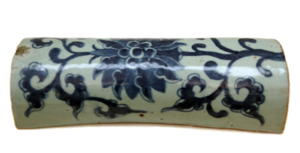
Connect Colors to Emotions
Audio Recording
Connect Colors to Emotions
Did you know that color can impact your mood? While some colors have specific cultural meanings, colors can also be subjective, or unique, to each person.
If joy were a color, what color would it be?
If blue were an emotion, what would it feel like?
Pick a color of yarn from the bin below and wind it around the pegs to the word and emoji that you think best expresses the emotion of the color.
- Pick an emotion.
- Choose the color of yarn from the bin that matches the emotion and pull upward.
- Weave the yarn toward the emotion word and emoji.
- Wrap the end of the yarn around the peg to secure.
- Cut the yarn at the base and secure the other end.
- Repeat with a new color.

Play with Light + Shadow
Audio Recording
Play with Light + Shadow
Gently move your body, cast a shadow, and create colors of the rainbow.
Notice what happens when two colors overlap.
What new colors do they make?
The experience of color is the result of your eyes and brain perceiving the wavelengths of light. The white light that is shining on the wall contains all the colors of the light color spectrum and its corresponding wavelengths. When you place an object in front of that light, some light will bend around the object. The wavelength of light determines the amount of bending, resulting in the color that you see.

Search + Find
Audio Recording
Search + Find
Notice Colors in Nature
Use your observational skills to find all the colors of the rainbow.
Choose a blue or purple Find It deck from the bins below to start your search!
Color is used in nature for camouflage, communication, and to regulate body temperature. While all colors exist in nature, did you know blue is the rarest?
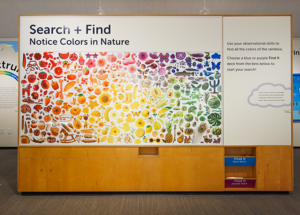
Cheryl Sorg, Raining Upward
Audio Recording
Cheryl Sorg
(b. 1967, Cincinnati, OH)
Raining Upward, 2024
tape, plastic sheet, and jump rings
Boise Art Museum Permanent Collection
New Acquisition
Raining Upward, by Cheryl Sorg, expresses the interconnected nature of rain, the sun, and rainbows. Each of the 2,800 raindrops in this artwork holds a rainbow of color within its luminescent finish. Through this artwork, the artist gives us an everlasting rainstorm of rainbows.
